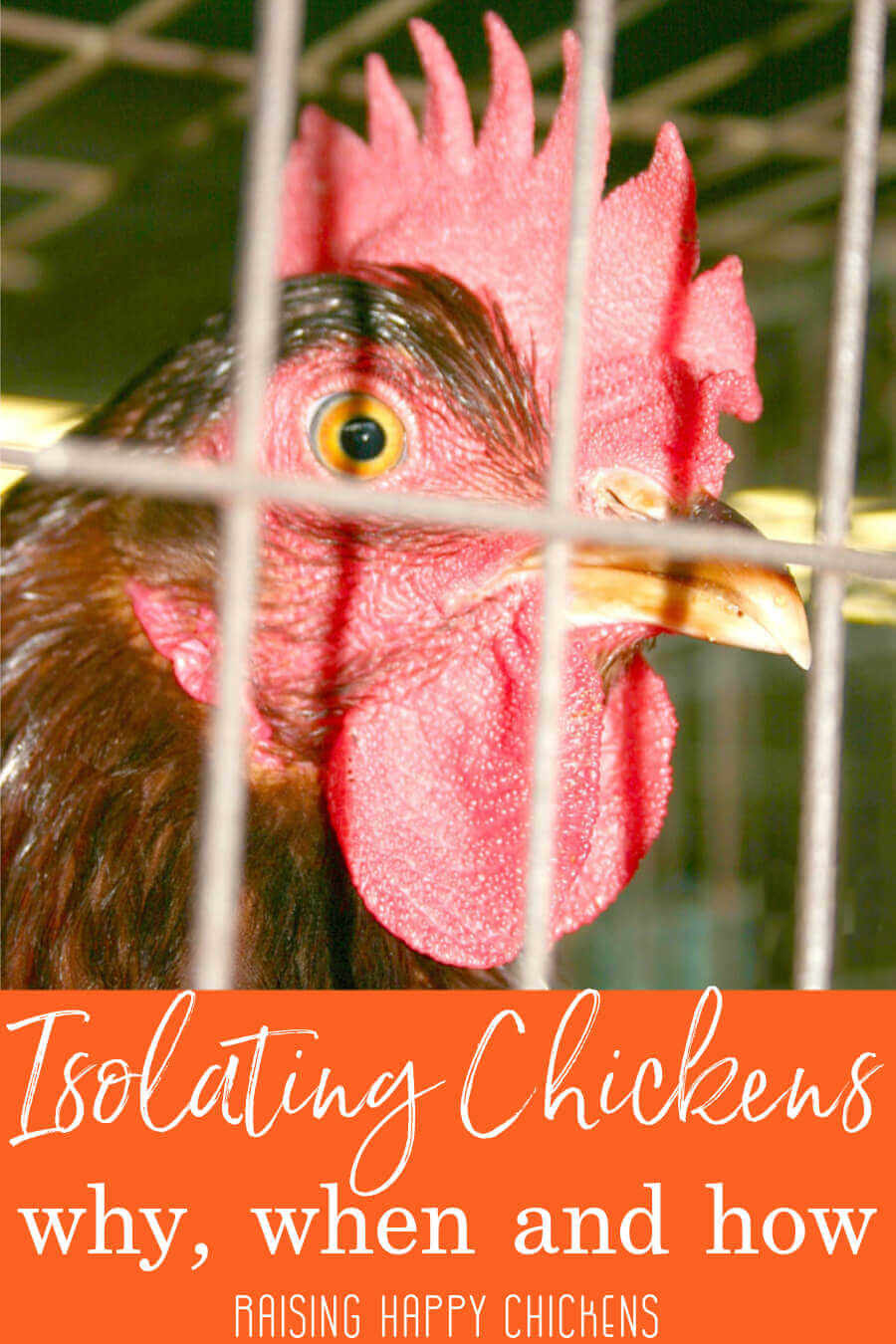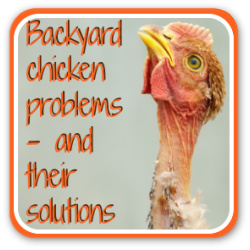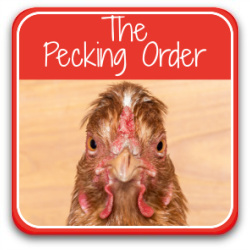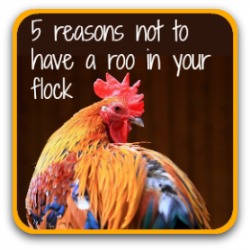Solitary confinement for chickens: when, why and how to do it.
There are times when chickens need to be separated from the rest of the flock for their own good, and other times when sentencing to isolation may do more harm than good.
Here's how to judge when solitary confinement is the right thing to do, why it might be necessary, and how to manage it.
- General suggestions about isolation for chickens.
- Don't wait to plan this until you need to separate one of your girls (or boys) from the rest of the flock. Plan before it happens. Otherwise when the time comes, you'll panic - and you may cost a chicken its life.
- Planning should take account of two different scenarios: what to do if you need to isolate a hen from the rest of the flock and keep them completely apart;
- and what to do if you needed to separate one bird but allow it to be within sight and sound of its buddies.
- Whichever it is, there are some things which will be common to both situations, namely:
- Wherever you place your isolation crate needs to be draught-free and protected from heat.
- The isolated bird will need to have easy access to both food and drinking water, particularly if it's in isolation because it's ill.
If you purchase a product through links on this page, I may receive a small commission at no extra cost to you. I only recommend products I have bought (or would buy) myself, and which I believe will genuinely benefit you. You can read my full disclosure policy here.
Here's a quick summary of the basics you may need at a moment's notice.
- An isolation container. I use a large, wire dog crate like this one. Details as to why further down.
- Failing that, a cat carrier, tote box or other large container such as a garden tools container box. More about this later.
- If it has no lid you'll need a way of covering it to prevent escape. I use chicken wire, hardware cloth or the grill from a large outdoor barbecue depending what I have to hand. They all work well.
- Covering for the bottom to prevent slipping, particularly if you need to house very young chicks.
- Bedding such as wood shavings or straw. I do not recommend sand as bedding in a sick bay. The grit can aggravate wounds.
- Containers (such as you'd use in a brooder) for food and water which are small enough to be fit in the crate, but stable enough not to spill.
- Your poultry First Aid kit.
When a hen doesn't want to be confined...
You'll soon discover that, even if you're isolating a chicken for its own good, it really doesn't appreciate your care.
This is how Matilda, one of my hens, reacted when she was isolated because she wanted to brood eggs. I had to stop her because she never, but never followed through!
Solitary confinement: when is complete isolation the only option?
It's not automatically a good idea to separate a bird from the rest of the flock. Re-integrating them can be a problem. And chickens are sociable creatures – they don't like being by themselves.
But there are times when it's absolutely critical to keep a chicken apart from other flock members. Here are some of them.
- Broody hens like Matilda (above) who, for whatever reason, can't continue to sit on eggs. Hens will sometimes refuse to eat or drink when brooding, and that clearly can't be allowed to continue.
- New flock members: If you introduce new birds from outside your own flock you need to keep them quarantined for at least two weeks. That is enough time to allow any diseases or illness to become apparent. It's particularly important at times when bird flu is circulating.
- Mixing them in with your existing hens straight away runs the risk of introducing disease - even if you think you can trust whoever you bought them from.
- Chickens bought in from a show: It's particularly important to observe quarantine if you buy from a show. Don't assume show birds will be disease free. So many in close proximity to each other can be a breeding ground for bacteria which may not become obvious for up to two weeks.
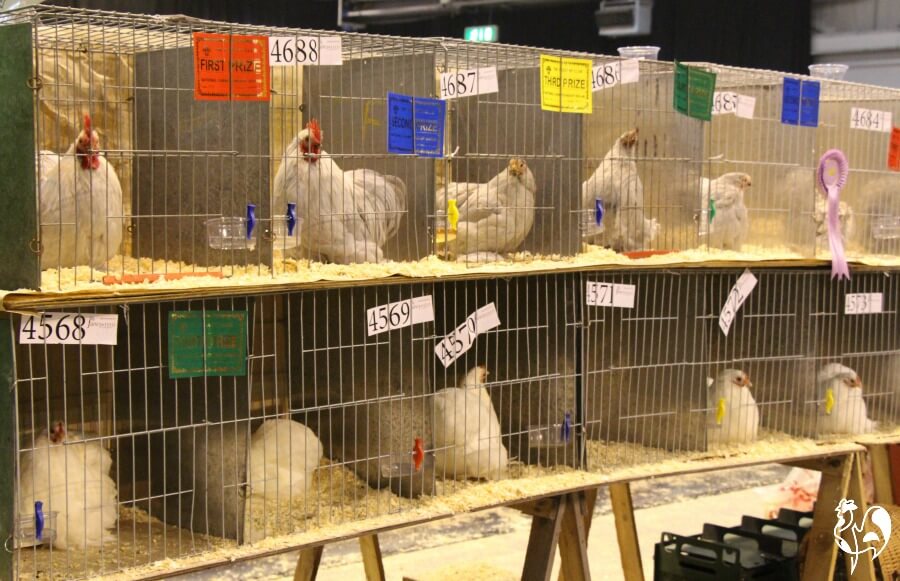 Show chickens may pick up a problem from their neighbour.
Show chickens may pick up a problem from their neighbour.- Wheezing: If you have any chickens who are displaying signs of bronchial problems, keep them isolated from the rest of the flock. Coughing, sneezing and wheezing are all tell-tale signs.
- Chickens who look generally unwell: It's not always easy to tell what's wrong with a chicken. Sometimes they just appear listless and 'hunched up' without there being an obvious reason. In those circumstances, isolate until you're certain it's not going to be a problem for the rest of the flock.
- Other things to be aware of: When a chicken is 'hunched over' and / or fluffed up; if their poop has any sign of blood; if their comb and / or wattles look particularly pale; if they aren't eating or, importantly, drinking; if their breathing is laboured; if they're 'panting' - breathing heavily through an open beak.
When confinement doesn't have to be completely solitary.
If you've ever had to introduce newcomers to your flock you'll know that it's not an easy task. It affects the pecking order and it can create sometimes quite unpleasant battles.
The same applies to re-introducing a bird who has been away from the flock for longer than a day or so.
So removing a chicken completely from the rest of the flock is best avoided if it can be. These are circumstances where it may be necessary to separate, but not isolate, your flock members.
- Any signs of injury or bleeding: chickens are ruthless. The fact that they're attracted to red means that, no matter how long they've lived together, any sign of blood will lead to pecking and can ultimately cause death. This would apply to a bird who, for example, has had an injury caused by a sharp object.
Here's an example: Bono, my little bantam Sablepoot rooster, had injured his leg and wasn't able to move. Before I found him, the flock had pecked at his comb, probably out of curiosity about why he wasn't moving about with them.
He needed isolating to allow his leg to heal and to prevent further injury. Left with the flock, his "friends" would have kept pecking the bloodied parts.
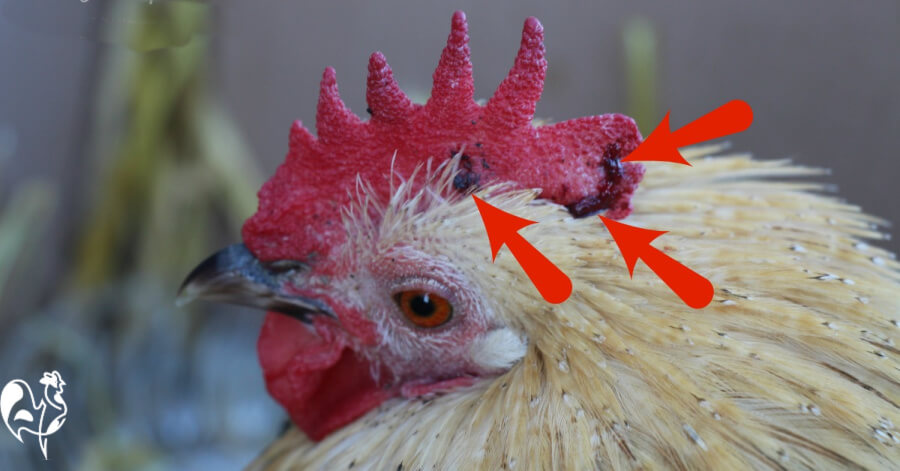
- A bully: any chicken who is deliberately bullying others may need to be removed from the flock for a while. But in this case, it's very important s/he's kept within sight and sound of the others.
- Non-contagious illness: a bird who is unwell for any reason other than a potentially transmitting illness, for example an injury to its leg or wing, or a prolapsed vent.
- The individual will need time separated from the flock to avoid being bullied, pecked or trampled, but does not need to be taken away from them altogether. He or she just needs a place of safety for a while.
Setting up a suitable place for solitary confinement.
- If the chicken needs to be isolated – that is, removed from the flock completely – find a space which is quiet, draught-free and shaded, at a distance from the coop. It should also be away from family members who may knock into it and in particular from pets. A sick bird does not need any additional stress.
- If s/he needs to stay separate but within sight of the rest of the flock and your run is large enough, section one part off and add a small coop. Something like the Omlet walk-in runs are ideal for this.
- Otherwise, place the container in the coop itself, if there's room. Again, it should be away from draughts.
- Whichever container you use, make sure other flock members can't get into it.
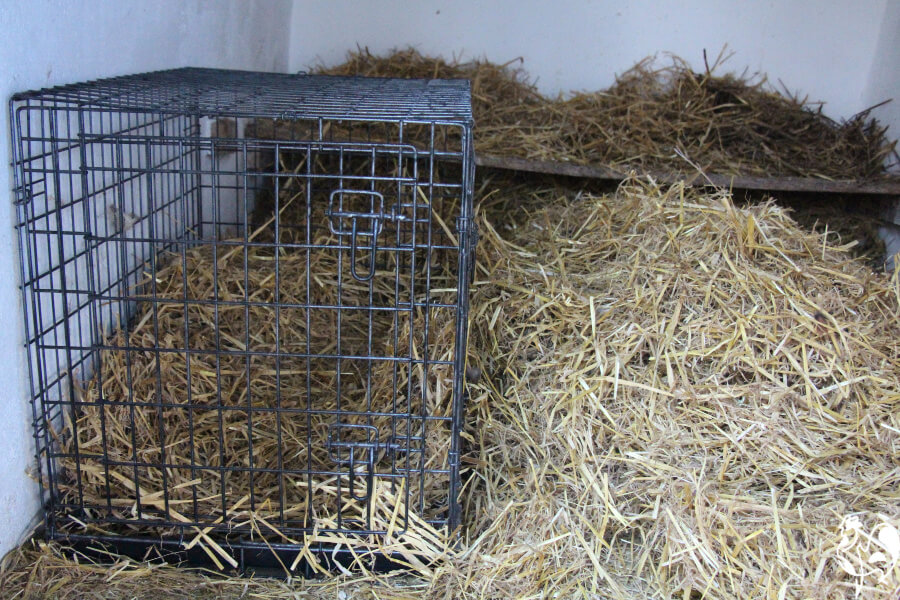 My dog crate sick bay, placed in the coop. The straw gives extra insulation for a sick or injured chicken.
My dog crate sick bay, placed in the coop. The straw gives extra insulation for a sick or injured chicken.What works best as an isolation container?
- Dog crate: This is the ideal option for a way of keeping chickens in solitary confinement, whether they're able to be near the rest of the flock or have to be completely alone.
- It's large enough for the chicken to stand, turn and sit comfortably. It's accessible for cleaning and adding food and water, portable so can quickly be put in place, and provides an easy way of hanging a drinking water bottle.
- The open mesh means the isolated chicken can see and hear the rest of the flock, too.
- Because a crate is small enough to be left in a reasonable sized coop, it also allows visits from flock members without any danger to the injured bird. This means they don't have to be re-introduced to the flock later, which can in itself be traumatic as the pecking order is re-affirmed.
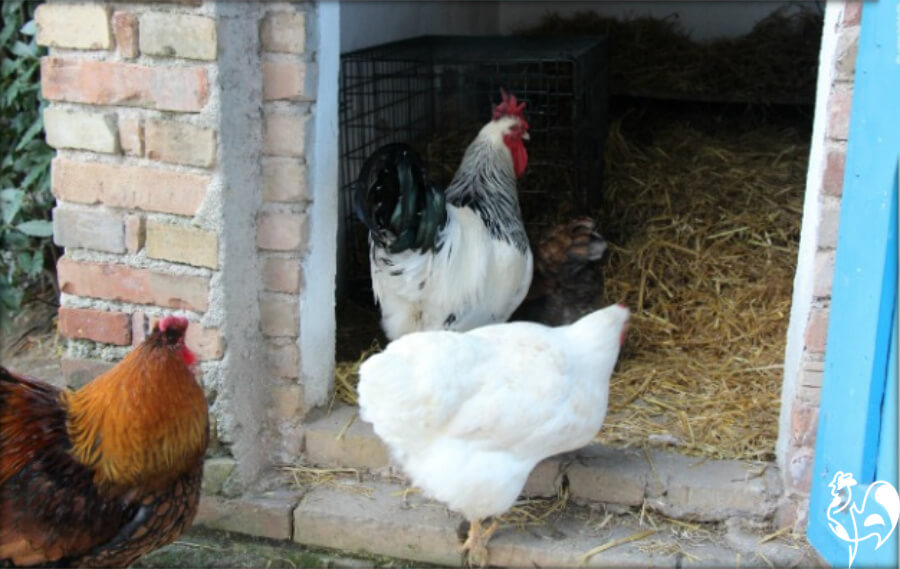 My isolation cage placed in the coop which allows for sick visits!
My isolation cage placed in the coop which allows for sick visits!- It's also possible to place a smaller, plastic dog or cat carrier within the larger crate as a sleeping compartment whilst having the crate as a (very small!) yard. This gives the chicken the opportunity to stretch their legs and keeps food in a separate place so it doesn't spill as easily.
- I've also used a dog crate enclosed within the puppy pen brooder I use for young chicks. That allows more space for a recovering chicken to move about.
Where to find a crate.
- A lot of people use these wire crates for puppy-training and want to get rid of them once the puppy has grown into an adult. So e-Bay and Craigslist can be a good place to start.
- Pet shops usually stock these too, but they tend to be quite expensive when compared to online prices.
- The crate I use is sold by Amazon. I chose it because it's large, has a latch which can't easily be opened and folds away flat when not in use – a great space saver.
What may be suitable as a solitary confinement container for chickens?
If you don't have a dog crate and don't want to buy one, here are some other methods I've tried over the years.
- Your bathroom: Been there, done that, would never, never do it again!
- I once brooded 16 chicks in a spare bathroom during a particularly cold spell when temperatures plummeted. The brooder lamp couldn't keep them warm enough and the bathroom was nice and cosy.
- If you use this kind of situation, make sure you put a non-slip cover and bedding on the tiled floor to prevent spraddle leg and other leg injuries. Cover the toilet, basin and bath.
- I cleaned my bathroom out every day, but it still ended up looking like this ...
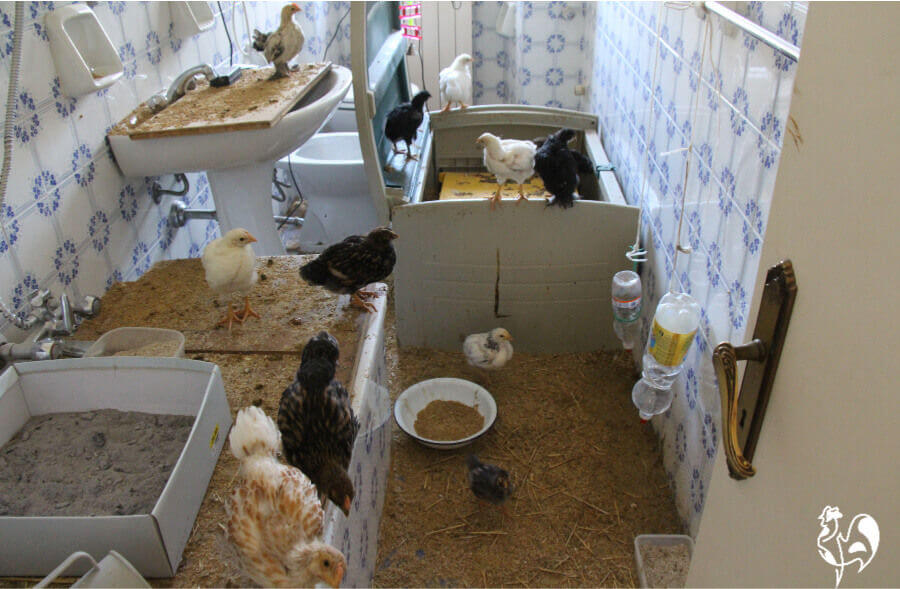
- However, there's a difference between brooding groups of chicks and isolating one or two hens. Somewhere in your home can be a good choice if you have chickens who need isolating away from the flock and the weather is freezing.
- If you do choose this, remember that chickens do not need powerful indoor heating - they have feathers. Unless your hen is very ill and in need of great warmth, switch radiators right down or turn them off altogether.
- Be aware that it will take you a very long time to restore your room after they've finished with it, no matter how careful you are.
- Large garden tools container or tote box: I use these as a brooder for new chicks (different sizes as they grow) but they're also excellent for containing a hen who needs to be away from her friends altogether.
- The solid sides ensure that cold draughts don't penetrate and the tops are easily covered - I use the grill trays from an outside barbecue.
- Again, the bottom needs covering to prevent slipping, particularly with young or sick chickens.
- Hang bottled water from the top using chicken wire or the grill. Hanging waterers like this one keep the container dry and make sure the chicken doesn't overturn a ground-based container.
What may not be suitable as a solitary confinement container?
- Cardboard boxes can be used as an emergency measure if you have nothing else.
- But although it's convenient, poop turns cardboard into a wet, smelly mess very quickly. And warm, humid conditions breed bacteria.
- Cardboard is a good short-term emergency solution and good for chicken day-care, but it's not a longer term solution.
- Nest boxes: This will only work as an emergency solution if you have nothing else available. Nest boxes can't be isolated, so only use them for keeping chickens separated but within sight and sound of the flock.
- It's very difficult even to keep hens in nest boxes separated, let alone isolated. They often line up to use the same one to lay in, even when there are several others available.
- If you have one that's never used and is relatively large, it's not difficult to attach some chicken wire over the front, line it with some form of bedding and add small food and water bowls.
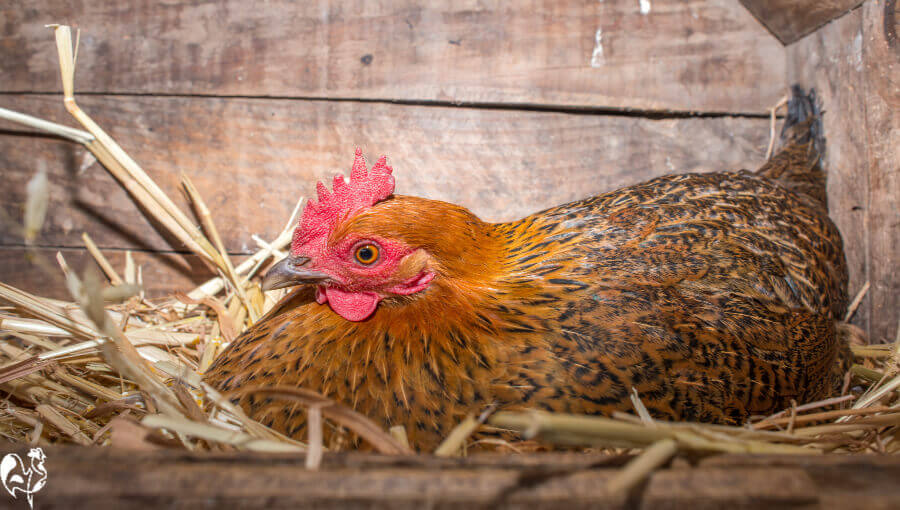 Nest boxes are generally too well used to make good isolation units.
Nest boxes are generally too well used to make good isolation units.- The major disadvantage of this method is that nest boxes are often small. Your isolated hen needs space to stand up, stretch her wings and turn around.
- Adding water bowls in a confined space can lead to wet bedding when it gets knocked over, and confining a warm hen to such a small space for any length of time can also lead to a breeding ground for mites.
- So again, use nest boxes if you're desperate and have nothing else.
But a much better option? Plan, and buy something appropriate now, before you need to use solitary confinement for your chickens!
If you found this page helpful, you may also like these.
Sources.
A lot of "facts" you'll find on the internet are often people's individual views, based on inaccurate information repeated from poor quality sources.
The information I provide in this article and others is based not just on my own experience, but on evidenced facts from scientific, peer-reviewed research and books from highly respected and experienced poultry keepers such as Gail Damerow.
Some of the trusted sources I have used in this article are these.
Marino, L.: Thinking Chickens: a review of cognition, emotion and behavior in the domestic chicken. Pub. Journal of Animal Cognition, 2017.
Guru et al: Some effects of confinement on laying pullets. Pub. Journal of British Poultry Science, 2007.
